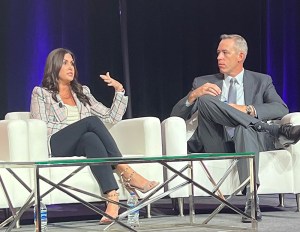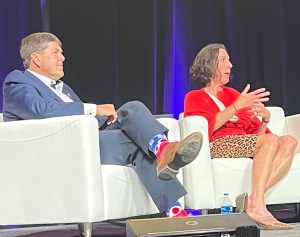Office Trends, Takeaways From SIOR CREate 360
More than ever, tenants want to make the office an amenity for their employees, experts say.

Aarica Mims, senior vice president & director of leasing, KDC Real Estate Development & Investments, and Jim Carman, Houston region president, Howard Hughes Corp.
With the advent of hybrid work, there are concerns that corporate America is de-emphasizing the office and that the office market is in peril. But many businesses are actually elevating the office to an even more important function. Developers are responding by making their buildings as amenitized and functional as possible.
During a panel at SIOR CREate 360 in Dallas, Texas-based executives from three leading development companies—Billingsley Co., KDC and Howard Hughes Co.—discussed the impact of this and other trends on office development. Here are some key takeaways from their remarks.
Flight to Quality
Tenants want to be in the best location with the most high-end amenities possible so they can give employees a reason to return to the office and make the office a powerful recruitment and retention tool, the panelists said.
READ ALSO: Industrial Trends, Takeaways from SIOR CREate 360
“There is more pressure on landlords to make the building an amenity,” said Jim Carman, president of the Houston region for Howard Hughes Corp.
Amenities developers and owners are adding to their buildings include community lounges, coffee service throughout the day, wine service in the evening, such outdoor amenities as patios and rooftop terraces, and high-end fitness centers. “All these new developments are going to have a hospitality feel,” noted Aarica Mims, senior vice president & director of leasing for KDC Development & Investments.
Billingsley Co. Partner Lucy Burns emphasized the food amenities and other conveniences. “Overlay anything that is practical,” she advised. “Food is huge. We all eat three times a day.”
As for location, she said, tenants favor an urban feel with walkability, but they want to be surrounded by suburban amenities so employees can complete personal tasks when traveling to and from the office and during lunch.
Suburban locations are also a draw because post-COVID, employees want a connection to nature and want to be closer to home. “We have had very good success with relocations to the Woodlands and not all for tax purposes,” said Carman. “It is really a connection to nature and health and wellness.”
Fully-amenitized buildings, however, need to be authentic, Mims cautioned. “You can’t just build it and walk away,” she said. “You have to program it.”
The flight to quality is happening in Class B buildings as well, but the accessibility of the location and the rents you can charge for the area must justify the investment, the developers said.
How long will the flight to quality and emphasis on amenities last? “It will continue to be a phenomenon as long as our employment rate is as low as it is, at sub-4 percent,” Burns predicted.
Larger Tenants Taking Their Time
The developers reported that many of their smaller tenants (20,000 square feet or less) have been back in the office since COVID or never left. Larger tenants, on the other hand, are slower to require all employees to return because many are still deciding how and how often they will use their space. Each tenant is determining what works for them. “Everyone is doing something different,” Mims noted.
Corporate America’s rethinking of the office is still in its early stages, Carman added, but it is clear the office will still be a critical component of operations and necessary for growth. Collaboration, innovation, and mentoring young people can best be accomplished in person, he noted: “You can only do so much online.”
Personal Space Still Matters
While tenants are seeking advice from architects on the optimal layout of their spaces, the developers do not see tenants getting rid of desks and cubicles because employees still want their own personal spaces when they do come into the office.
But it’s becoming more and more evident that buildings won’t need as much parking, and that extra space can be used for outdoor amenities. “Parking lots are going to be a huge opportunity,” said Burns. “There is too much parking. (Owners) are going to be reinventing themselves with parking.”
The New Normal
Kastle System’s Back-to-Work barometer for the 10 largest metros was 50 percent in mid-October—the highest level since the start of the pandemic, while Austin, Dallas and Houston all exceeded 50 percent. But Mims noted that even before the pandemic, offices were never fully occupied by employees. Some worked remotely part of the time and others were out most of the day on sales calls.
“We need to not monitor ourselves on 100 percent,” said Mims. “We were not 100 percent in March 2020. If we get to 80 percent, great.”
The panel discussion was moderated by David Lockwood, SIOR, Colliers.








You must be logged in to post a comment.